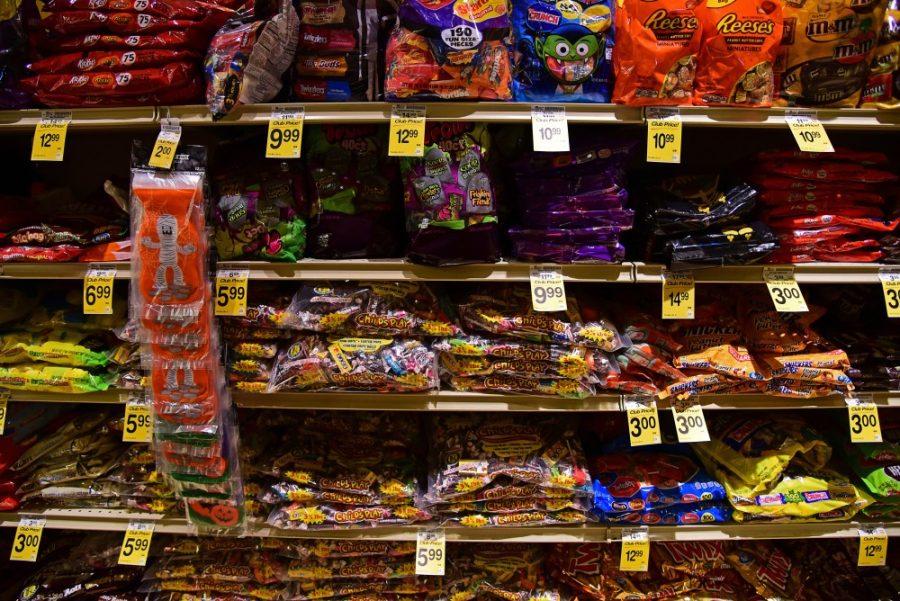Halloween, among other largely commercialized holidays, is an opportunity for rampant wastefulness.
Candies get packaged into smaller, individual packages, using more plastic for each piece. People purchase costumes, use them once and either stuff them away for eternity or throw them into the trash. Pumpkins are often picked, carved and neglected until someone comes to smash them.
“Most of our holidays have really become hyper-commercialized, consumeristic affairs,” said Ben Champion, director of the UA’s Office of Sustainability. “They are things that are based upon accentuating our consumption. Our consumer behaviors are a huge driver of a lot of environmental challenges.”
Champion said living in a sustainable manner is about being conscious of your life and the impacts your decisions have.
“Sustainability at its heart is all about our long-term societal future, so we have to figure out ways of working and playing that are more in tune to what the needs of each other are, as well as the natural world,” Champion said. “That includes all of our holidays. What are the things that you do for your holiday? That becomes the question.”
Holidays are a time to enjoy life and tradition with family and friends. With a little creativity and foresight, you can lower the impact your holiday practices have on the environment.
Here are five tricks for treating the planet during Halloween:
1. Wear recycled or hand-made costumes
Costumes are a huge part of Halloween tradition. In college, students often participate in Halloweek, wearing multiple costumes in the days leading up to Halloween.
Many store-bought costumes are created from materials such as cheap vinyl, which is produced using toxic methods that contribute significant amounts of pollution.
Try getting creative and pulling together a costume using old clothes you don’t really use anymore. Thrift stores are a popular way to find items for creating or completing a costume.
If you are planning to be a “sexy” anything for Halloween, help lower your environmental impact by making sure the few clothes you wear are being re-purposed, and don’t throw them out on Nov. 1.
RELATED: Tucson is packed with places for UA students to get thrifty with Halloween costumes
2. DIY decorations
If you are getting bored with the same decorations every year, try making your own. Getting crafty and creating new decorations to share with friends is a much more sustainable practice than buying new decorations each year.
Don’t fear creativity—think about what is really scary to you, and make it art. Try cutting out and hanging words from colored paper that scare you, such as ‘climate change’ or perhaps your least favorite presidential candidate’s name.
You could even fold up your collection of parking citations and hang them from the ceiling as a spooky warning to your friends.
3. Use the whole pumpkin
Pumpkins are perhaps the largest staple of American Halloween tradition. According to the U.S. Census, 40,900 acres of pumpkins were harvested in the U.S. in 2015. To avoid wasting most of the pumpkin by only carving it, try cooking up some delicious Halloween treats.
Try finding pumpkin puree recipes and creating bread, cookies or pies—pumpkin flesh can also be used in soups, casseroles and even smoothies. If the pumpkin you carved becomes inedible, compost it rather than throwing it away.
If you forgot to plant pumpkin seeds last year, try to get your pumpkins from local farms. Not only will you stimulate local economies, you will be cutting down on emissions-related pollution resulting from the transportation of pumpkins.
RELATED: Marana Pumpkin Patch continues to grow
4. Quintessential candy
Candy is another aspect of Halloween that is crucial, yet potentially very harmful for the planet.
There are other personal health concerns involved with the yearly ritual of arming America’s youth with weapons of mass confection, however.
Try to consider the health of the environment as well.
Try purchasing Fair Trade chocolate products. Most of the world’s cocoa is produced in a very small area around the equator and often in areas of conflict.
Fair Trade labels on chocolate products indicate that the cocoa was produced in accordance with more ethical and environmental standards.
If you participate in trick or treating, try creating your own candy-carrying apparatus this year. Pillow cases are easily decorated and voluminous enough for maximum sugar capacity.
5. Tricky transportation
When going to parties or the bars downtown for Halloween, try public transit.
Taking the streetcar or bus in Tucson can actually be pretty fun during Halloween.
Many riders will also have costumes on, and it’s a great way to make plans while cutting down on CO2 emissions.
If your Supergirl cape won’t get caught up in the spokes, opt to bike for transportation during Halloween.
If you absolutely plan on driving, try to carpool with friends.
“Many of our holiday activities are really kind of celebrating aspects of our culture that are not so great,” Champion said. “But they are the things that kind of energize us and connect us to family and connect us to friends. We need to have fun and celebrate the holidays.”
So try not to spook the planet too much during Halloween this year.
Avoiding wastefulness during holidays is much easier than you may think.
Follow Isaac Andrews on Twitter









